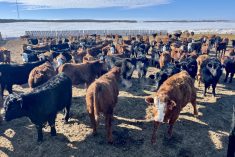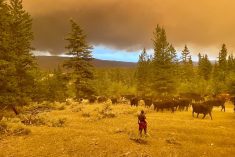Q. What is planned grazing?
A. Planned grazing was developed by Allan Savory. It is a term that describes the method used in H M to develop a grazing plan. Planned grazing is designed to stop overgrazing.
Q. What is overgrazing?
A. Overgrazing is a function of time. It can occur in two ways. The first is to stay in a pasture too long at one time (graze period). The second is by returning to the pasture for a second graze before the plants have fully recovered from the first graze (recovery period). Overgrazing is not related to the number of animals.
Read Also

What to know before you go to Agribition 2025
If you’re attending Agribition 2025, this is the place to find out about tickets, dates and what’s happening this year.
Traditionally overgrazing has been associated with the number of animals. Traditional grazing practices have focused on the percentage of utilization of the forage. The basic model has been to take half and leave half with the result that we overgrazed some of the plants each year. As long as we kept close to the 50 per cent theory things weren’t too bad but the long-term result has been that most pastures slowly deteriorated. We see more bare ground, an ineffective water cycle and more invasive species such as aspen, buck brush, silver willow and thistle.
Pasture rejuvenation was a major expense and over time our stocking rate declined. This is not a recipe for sustainability. Unfortunately this model is still promoted and accepted by many ranchers and range ecologists.
We now know overgrazing is a function of time. This is the main difference between traditional grazing and planned grazing. In H M we recognize we don’t overgraze a pasture but we do overgraze individual plants. This begins with the most desirable species and continues on down the line.
With planned grazing pastures improve over time. We have more desirable species, less bare ground and a more effective water cycle. Pasture rejuvenation is no longer necessary. This is a model that leads to profit in the short term and sustainability in the long term.
Q. What does the term graze period mean?
A. The graze period refers to the number of days that the cattle will be in a pasture at one time. The shorter the graze period, the better. As a guideline I suggest three to five days.
Q. What does the term recovery period mean?
A. This is the number of days between grazings. It has to be long enough to allow full recovery of the plants before they are grazed a second time. In most instances a recovery period of 60 to 90 days is required. My experience has been that as you move closer to the 90 days you will be more pleased with the results. If you live in a dry environment you might use an even longer recovery period.
Q. What does full recovery mean?
A. Full recovery occurs when the root supplies of a plant are fully replenished after the plant has been grazed. Grazing a second time at this stage of growth is beneficial to both the plant and the soil. The best indicator of full recovery is that the plant is ready to flower.
Q. How many pastures do I need to do a good job of grazing?
A. I don’t know. That can only be determined on an individual basis. With a five-day graze period and a 75-day recovery period you will need 16 pastures. The formula is recovery period (75)/graze period (5) + 1 = 16.
Q. What other information do I require?
A. It is important to have a method of determining when growth starts. Before growth starts and after growth stops you can’t overgraze, as the plants are dormant.
Overgrazing occurs in the growing season. In my area the best indicator of growth starting is the day the leaves appear on the poplar trees. There will be some growth before this date but I think it is marginal and can be overlooked. Once the leaves appear we need to implement our grazing plan to prevent overgrazing. For 10 years now at our place growth has started as early as April 20 and as late as May 18. Obviously having a set date for the start of growth will not be very effective.
Q. What does the term stocking rate refer to?
A. Stocking rate is the number of animals on a given piece of land for the growing season.
Q. Is stocking rate the same as stock density?
A. No. Stock density is the number of head per acre for a short period of time. The higher the stock density the more beneficial the grazing will be. The stock density is directly related to the graze period. For example if you planned to have a five-day graze period and then changed to a one-day graze period you would increase the stock density five times. The stocking rate would be unchanged.
Q. What does the severity of the graze mean?
A. The severity of the graze refers to how much residue is left when the cattle leave a pasture. The ideal is to leave as much grass behind as possible. However, to achieve full recovery in a variety of growing conditions we need to vary the severity of the graze depending on the growing conditions we are experiencing. You cannot manage for a set amount of residue unless you are willing to change your stocking rate during the growing season. It is important to realize that overgrazing and severe grazing are different.
Q. How do I get started?
A. You have the graze period and the recovery period selected. You now plan how you will move your animals through your pastures. You would do this before the grazing season begins. Once the growing season starts you monitor the regrowth in the first pasture grazed to see if it will be necessary to increase or decrease your recovery period. You will change the severity of the graze to change the recovery period. The result will be full recovery under all growing conditions.
Good luck. You have the information you need to stop overgrazing your pastures. The result will be healthier land, increased production, increased profit and sustainability.

















